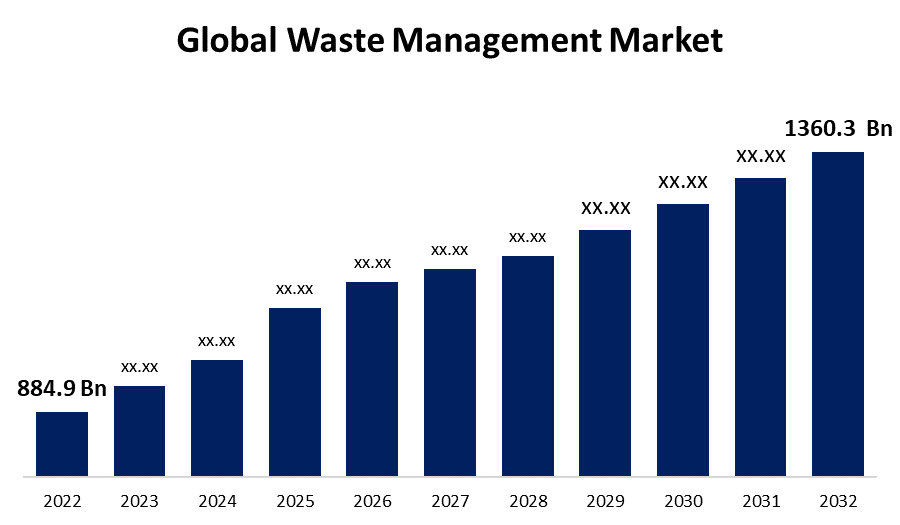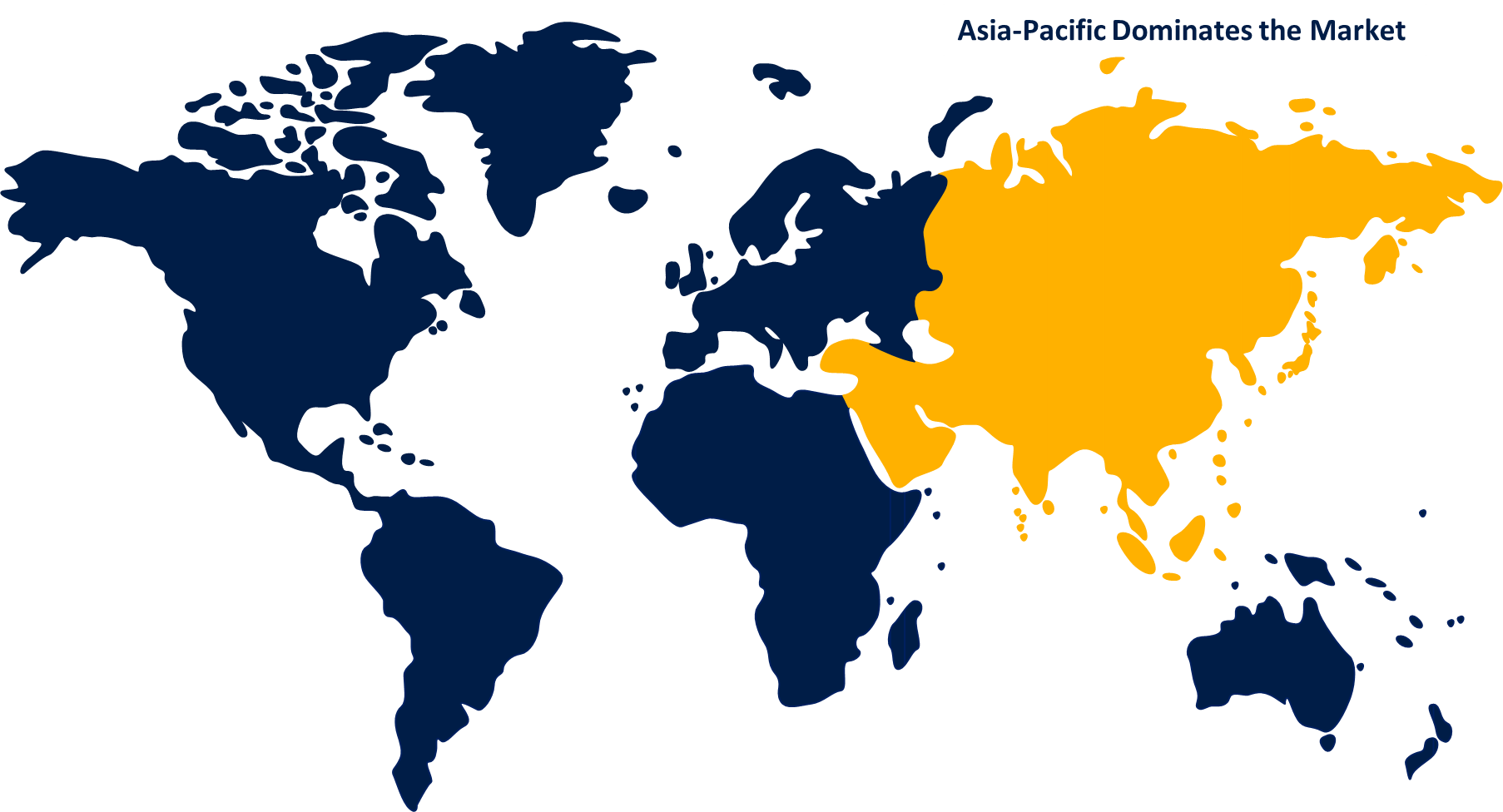Global Waste Management Market Size, Share, and COVID-19 Impact By Type (Municipal Waste, Industrial Waste); By Services (Collection, Disposal); By End-User (Commercial, Industrial, Residential),By Region (North America, Europe, Asia-Pacific, Latin America, Middle East, and Africa), Analysis and Forecast 2022 - 2032.
Industry: Chemicals & MaterialsGlobal Waste Management Market Size Insights Forecasts to 2032
- The Waste Management Market Size was valued at USD 884.9 Billion in 2022.
- The Market Size is Growing at a CAGR of 6.6% from 2022 to 2032
- The Worldwide Waste Management Market Size is expected to reach USD 1360.3 Billion by 2032
- North America is expected to Grow the fastest during the forecast period

Get more details on this report -
The global Waste Management Market Size is expected to reach USD 1360.3 Billion by 2032, at a CAGR of 6.6% during the forecast period 2022 to 2032.
Waste management is the methodical gathering, moving, processing, recycling, and disposal of waste products in a way that is both economical and environmentally friendly. Maintaining public health, lowering environmental pollution, and resource conservation all depend on effective waste management. Different types of waste are produced by homes, businesses, industries, and building sites. There are various varieties of it, including solid trash, liquid waste, and hazardous waste. To promote responsible waste management practises among the general public and businesses, it is essential to raise knowledge about the value of proper garbage disposal, recycling, and waste reduction.
Impact of COVID 19 On Global Waste Management Market Size
The makeup of the trash produced changed throughout the pandemic. There was a rise in domestic trash, particularly in the form of packing materials and single-use plastics, as a result of more people working from home and business closures. However, due to business closures, commercial trash reduced. Due to lockdowns, limitations, and variances in COVID-19 situations, the amount of waste produced changed over time and in different locations. For instance, waste generation decreased in places subject to stringent lockdowns, yet medical waste increased in locations with more patients and healthcare facilities. Due to worries about worker safety and the need to give regular rubbish collection priority, recycling programmes have temporarily been suspended or reduced in several locations. As a result, recycling rates fell during the pandemic.
Global Waste Management Market Report Coverage
| Report Coverage | Details |
|---|---|
| Base Year: | 2022 |
| Market Size in 2022: | USD 884.9 Billion |
| Forecast Period: | 2022-2032 |
| Forecast Period CAGR 2022-2032 : | 6.6% |
| 2032 Value Projection: | USD 1360.3 Billion |
| Historical Data for: | 2019-2020 |
| No. of Pages: | 200 |
| Tables, Charts & Figures: | 110 |
| Segments covered: | By Type, By Services, By End-User, By Region, and COVID-19 Impact |
| Companies covered:: | Advanced Disposable Services, BIFFA, Clean Harbors, Inc., Covanta Holding Corporation, Daiseki Co., Ltd., FCC Environment, Hitachi Zosen Corporation, Remondis SE & Co. K.G., Republic Services, Stericycle, SUEZ, Urbaser, Veolia Environment S.A., Waste Connections, Waste Management Inc. Group, and other key vendors. |
| Pitfalls & Challenges: | COVID-19 Empact, Challenge, Future, Growth & Analysis. |
Get more details on this report -
Key Market Drivers
The amount of waste produced considerably rises as the world's population keeps expanding and more people move into cities. Due to increased consumption and packaging materials, urbanisation has a tendency to result in higher trash output. Increased industrialization and commercial activity, which produce more industrial and commercial waste, are frequently associated with economic progress. As a result, there is an increased need for waste management services. The sorting, recycling, and disposal of garbage have all benefited from technology improvements in the waste management sector. Through these advances, waste management procedures are made more effective and have a smaller negative environmental impact. Anaerobic digestion and other waste-to-energy technologies have Grown in popularity as methods of transforming garbage into energy while minimising the need for landfill space. These innovations help the market expand.
Key Market Challenges
Waste generation rates keep rising, placing more strain on waste management infrastructure and resources as people and economies rise. Municipalities and businesses may experience budget difficulties due to the high cost of proper waste management, which has an impact on the standard and accessibility of trash services. Continuous public engagement and education campaigns are necessary to encourage recycling and promote ethical trash disposal practises. Waste management facilities and equipment may become antiquated, necessitating large investments to upgrade and modernise operations. It is crucial to address these emissions through mitigation measures because the waste sector contributes to greenhouse gas emissions through processes like landfilling and garbage incineration.
Market Segmentation
Type Insights
Industrial segment holds the largest market share over the forecast period
On the basis of type, the global waste management market is segmented into municipal and industrial. Among these, the industrial segment holds the largest market share over the forecast period. Industrial waste production rises in tandem with expanding economies and rising industrial output. Industries including mining, building, and manufacturing all contribute to the rise in industrial waste. Resource recovery programmes and waste reduction methods are becoming more widely used in many industries. Attempts to reduce waste generation, reuse materials, and recycle industrial wastes are included in this. These programmes have the potential to save waste management expenses while also generating income from recycled materials. The methods for sorting, treating, and recycling trash have profited from technological improvements in industrial waste management. Operations for trash management are being optimised via automation, robotics, and data analytics. Industries have potential to decrease waste and extract value as a result of the development of innovative waste management technologies including chemical recycling and waste-to-fuel processes.
Services Insights
Disposal segment is dominating the market over the forecast period
Based on the services, the global waste management market is segmented into collection and disposal. Among these, the disposal segment is dominating the market over the forecast period. Waste-to-energy incinerators and other disposal facilities are needed to handle the expanding amount of waste produced as the world's population and urban areas continue to Grow. trash-to-energy (WTE) technologies, such as anaerobic digestion and incineration, have Grown in popularity because they make it possible to turn trash into electricity. This decreases the need for landfill space while also generating electricity, making WTE facilities a Growth market within the disposal industry. Before they are finally disposed of, some disposal facilities are implementing resource recovery methods to remove valuable elements from waste streams. This gives the waste more value and may help the disposal market flourish. The disposal industry may be impacted by initiatives to divert garbage from landfills through recycling and composting.
End User Insights
Residential segment is witnessing the rapid market Growth over the forecast period
On the basis of end user, the global waste management market is segmented into commercial, industrial, and residential. Among these, the residential segment is witnessing the rapid market Growth over the forecast period. There are more households as the world's population continues to rise, which results in increasing amounts of domestic garbage. Trends towards urbanisation lead to increasing population densities in cities and towns, where households produce a lot of waste. Effective household trash management services are therefore required. Growing public knowledge of recycling and environmental issues has encouraged participation in domestic waste reduction initiatives as well as recycling programmes. Residential trash management services are more effective and efficient because to technology-driven solutions like smart waste collection systems and smartphone apps for scheduling collections.
Regional Insights
Asia Pacific region holds the largest market share over the forecast period

Get more details on this report -
Among all other regions, Asia Pacific regions holds the largest market share over the forecast period. APAC is rapidly urbanising, with millions of people relocating to urban areas each year. The infrastructure and services for trash management are under pressure as a result of this trend's increased garbage creation in urban areas. Packaging garbage, electronic waste (e-waste), and construction debris are among the types of waste that are produced more frequently in APAC nations due to the expanding middle class and shifting consumption habits. The APAC region produces a variety of wastes, including plastic, hazardous, and organic garbage. It takes specialised infrastructure and technology to manage this diversity. To solve the problem of garbage disposal and produce renewable energy, certain APAC nations are investing in waste-to-energy technologies including anaerobic digestion and incineration.
North America is witnessing the fastest market share over the forecast period. One of the major waste management markets in the world is in North America. Because of things like population expansion, urbanisation, and industrialization, it has seen consistent increase over time. Populations are expanding and urbanisation is widespread throughout the United States, Canada, and Mexico. Large amounts of garbage are produced as a result, mainly in urban areas. Waste produced in North America includes industrial waste, construction and demolition waste, hazardous waste, and electronic garbage (e-waste). Each region has a different waste composition.
Recent Market Developments
- In February 2020, to improve its position as one of the top suppliers of wastewater treatment services in the nation and to expand its network in the United States, Valicor purchased Affiliated Wastewater Environmental Services.
List of Key Companies
- Advanced Disposable Services
- BIFFA
- Clean Harbors, Inc.
- Covanta Holding Corporation
- Daiseki Co., Ltd.
- FCC Environment
- Hitachi Zosen Corporation
- Remondis SE & Co. K.G.
- Republic Services, Stericycle
- SUEZ
- Urbaser
- Veolia Environment S.A.
- Waste Connections
- Waste Management Inc. Group
Market Segment
This study forecasts revenue at global, regional, and country levels from 2019 to 2032. Spherical Insights has segmented the global Waste Management Market based on the below-mentioned segments:
Waste Management Market, Type Analysis
- Municipal
- Industrial
Waste Management Market, Services Analysis
- Collection
- Disposal
Waste Management Market, End User Analysis
- Commercial
- Industrial
- Residential
Waste Management Market, Regional Analysis
- North America
- US
- Canada
- Mexico
- Europe
- Germany
- Uk
- France
- Italy
- Spain
- Russia
- Rest of Europe
- Asia Pacific
- China
- Japan
- India
- South Korea
- Australia
- Rest of Asia Pacific
- South America
- Brazil
- Argentina
- Rest of South America
- Middle East & Africa
- UAE
- Saudi Arabia
- Qatar
- South Africa
- Rest of Middle East & Africa
Frequently Asked Questions (FAQ)
-
1. What is the market size of 1,4 Butanediol Market?The global 1,4 Butanediol Market is expected to grow from USD 11.5 Billion in 2022 to USD 19.3 Billion by 2032, at a CAGR of 10.4% during the forecast period 2022-2032.
-
2. Who are the key market players of 1,4 Butanediol Market?Some of the key market players of BASF SE, Ashland Inc., Dairen Chemical Corporation, Mitsubishi Chemical Corporation, Nan Ya Plastics Corporation, SK Global Chemical Co., Ltd., Bioamber Inc., Mitsui Co. & Ltd., Chongqing Jian Feng Chemical Industry Co. Ltd and Chemtura Corporation
-
3. Which segment hold the largest market share?Davy process segment holds the largest market share is going to continue its dominance.
-
4. Which region is dominating the 1,4 Butanediol Market?Asia Pacific is dominating the 1,4 Butanediol Market with the highest market share.
Need help to buy this report?